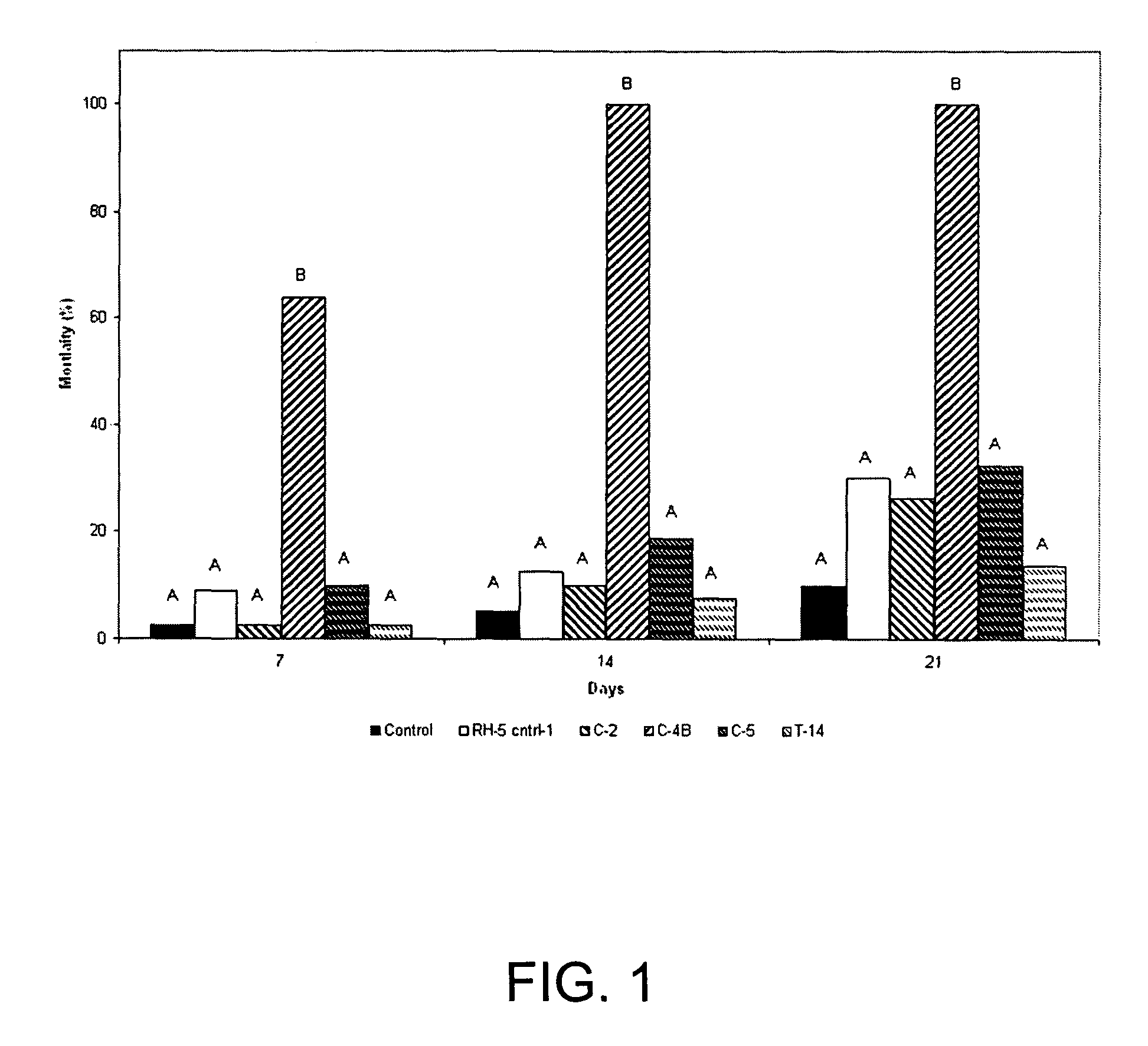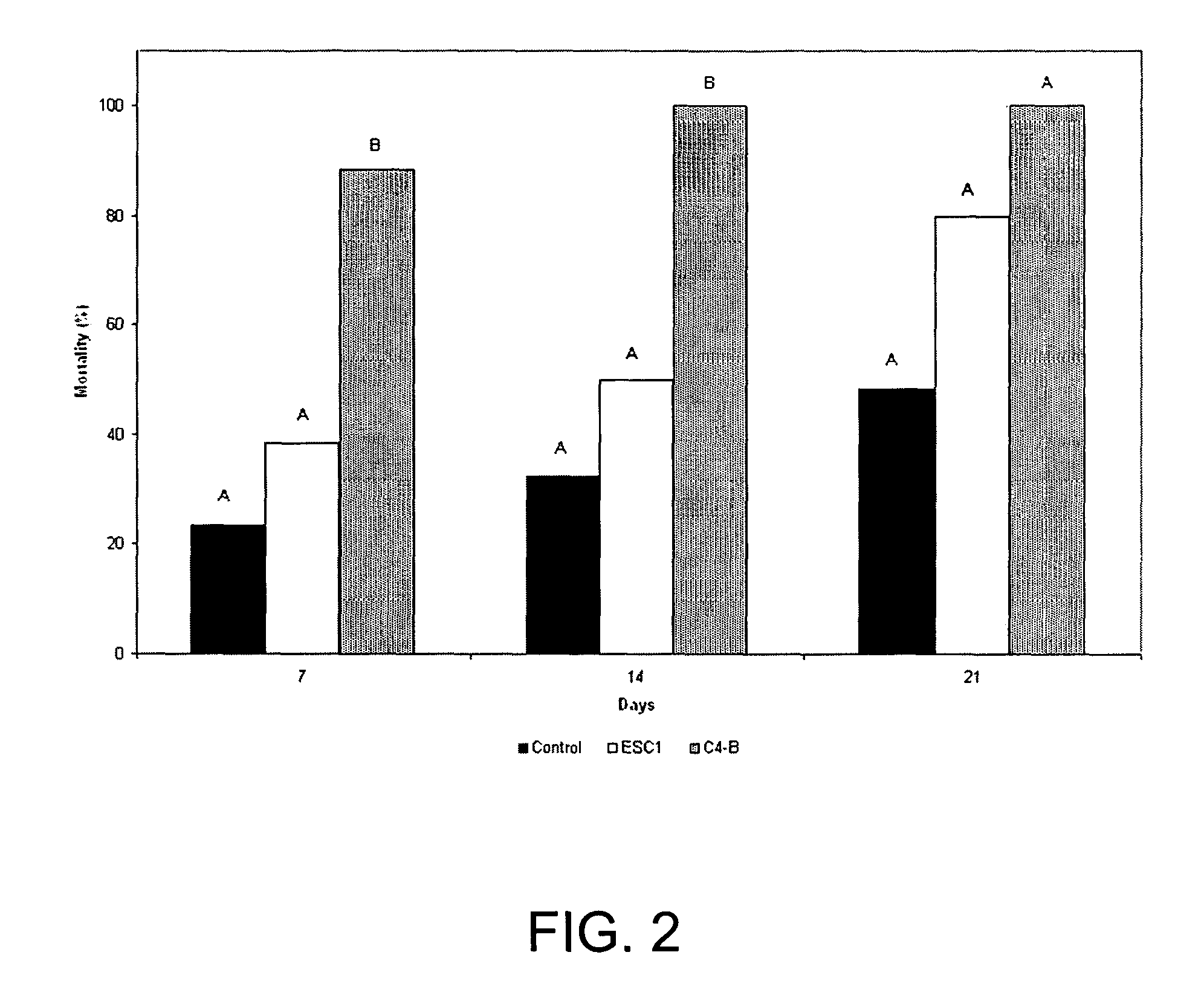Strain of the fungus Metarhizium anisopliae for controlling subterranean termites
a technology of metarhizium anisopliae and fungus, which is applied in the field of fungus metarhizium anisopliae strain, can solve the problems of only moderate mortality rate over relatively long periods, rapid mortality of termite workers, etc., and achieve the effect of rapid mortality and control of termite infestations
- Summary
- Abstract
- Description
- Claims
- Application Information
AI Technical Summary
Benefits of technology
Problems solved by technology
Method used
Image
Examples
example 1
Collection of Termite Workers
[0041]Formosan subterranean termite workers, third instar or older based upon size, were obtained from bucket traps (Su and Scheffrahn. 1986. Sociobiol. 12: 299-304) set up at the Southern Regional Research Center, City Park, and the University of New Orleans, all of which are located in New Orleans, La. Formosan subterranean termite workers from four different colonies of termites were chosen to prevent colony vitality biasing of data.
example 2
Collection and Identification of the Fungal Strains
[0042]In 2002, alates of C. formosanus were collected in universal black light traps (BioQuip, Gardena, Calif.) from several locations in New Orleans, La., between April and June, the normal swarming season. Termites were removed from the light traps within one hour, held overnight in plastic boxes containing moist paper towels, and brought to the laboratory the following morning. The alates from one particular collection in 2002 showed unusually high, rapid mortality; all alates died within 48 hours. Fungal mycelia and spores were visible on the cadavers. Several fungal strains isolated from the alate cadavers were purified individually.
[0043]Conidia were transferred from the dead alates onto potato dextrose agar (PDA) using sterile transfer loops. The plates were incubated at 25° C. for four to seven days until the mixed cultures sporulated. Fungal conidia were transferred to fresh PDA and incubated for an additional seven days at...
example 3
Mortality Assays
[0045]In 2003, effectiveness of C4-B was evaluated by exposing FST workers to either ESC 1, a strain of M. anisopliae produced commercially for control of termites under the product name BioBlast® or the newly identified strain C4-B. In initial experiments, the pathogenicity of strains C4-B and ESC 1 was compared by placing 20 FST workers from each of four colonies into a Petri dish (90×10 mm diameter) containing spores of strains C4-B or ESC 1, then incubating the termites on moistened filter paper.
[0046]Cultures of both C4-B and ESC 1 were grown for seven days at 25° C. on PDA. Spores were then harvested from the plates by scraping with a sterile spatula. An estimate of the number of spores was made using a hemacytometer (Hausser, Horsham, Pa.). A total of 6.5×1010 spores of either C4-B or ESC 1 mixed with silica in a total volume of 1.5 g were individually distributed over the surface of moistened filter paper in Petri (90×10 mm diameter) dishes. The plates were i...
PUM
| Property | Measurement | Unit |
|---|---|---|
| diameter | aaaaa | aaaaa |
| RH | aaaaa | aaaaa |
| diameter | aaaaa | aaaaa |
Abstract
Description
Claims
Application Information
 Login to View More
Login to View More - R&D
- Intellectual Property
- Life Sciences
- Materials
- Tech Scout
- Unparalleled Data Quality
- Higher Quality Content
- 60% Fewer Hallucinations
Browse by: Latest US Patents, China's latest patents, Technical Efficacy Thesaurus, Application Domain, Technology Topic, Popular Technical Reports.
© 2025 PatSnap. All rights reserved.Legal|Privacy policy|Modern Slavery Act Transparency Statement|Sitemap|About US| Contact US: help@patsnap.com



